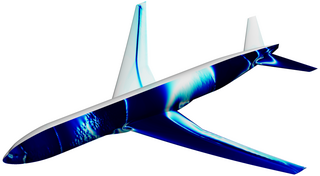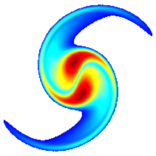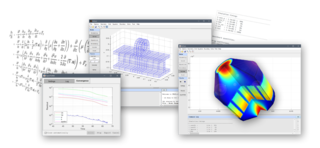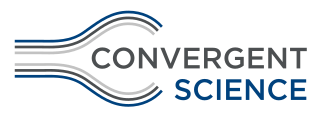Related Research Articles

In physics, physical chemistry and engineering, fluid dynamics is a subdiscipline of fluid mechanics that describes the flow of fluids—liquids and gases. It has several subdisciplines, including aerodynamics and hydrodynamics. Fluid dynamics has a wide range of applications, including calculating forces and moments on aircraft, determining the mass flow rate of petroleum through pipelines, predicting weather patterns, understanding nebulae in interstellar space and modelling fission weapon detonation.

Computational fluid dynamics (CFD) is a branch of fluid mechanics that uses numerical analysis and data structures to analyze and solve problems that involve fluid flows. Computers are used to perform the calculations required to simulate the free-stream flow of the fluid, and the interaction of the fluid with surfaces defined by boundary conditions. With high-speed supercomputers, better solutions can be achieved, and are often required to solve the largest and most complex problems. Ongoing research yields software that improves the accuracy and speed of complex simulation scenarios such as transonic or turbulent flows. Initial validation of such software is typically performed using experimental apparatus such as wind tunnels. In addition, previously performed analytical or empirical analysis of a particular problem can be used for comparison. A final validation is often performed using full-scale testing, such as flight tests.

In fluid dynamics, turbulence modeling is the construction and use of a mathematical model to predict the effects of turbulence. Turbulent flows are commonplace in most real-life scenarios, including the flow of blood through the cardiovascular system, the airflow over an aircraft wing, the re-entry of space vehicles, besides others. In spite of decades of research, there is no analytical theory to predict the evolution of these turbulent flows. The equations governing turbulent flows can only be solved directly for simple cases of flow. For most real-life turbulent flows, CFD simulations use turbulent models to predict the evolution of turbulence. These turbulence models are simplified constitutive equations that predict the statistical evolution of turbulent flows.
A direct numerical simulation (DNS) is a simulation in computational fluid dynamics (CFD) in which the Navier–Stokes equations are numerically solved without any turbulence model. This means that the whole range of spatial and temporal scales of the turbulence must be resolved. All the spatial scales of the turbulence must be resolved in the computational mesh, from the smallest dissipative scales, up to the integral scale , associated with the motions containing most of the kinetic energy. The Kolmogorov scale, , is given by
In fluid dynamics, turbulence kinetic energy (TKE) is the mean kinetic energy per unit mass associated with eddies in turbulent flow. Physically, the turbulence kinetic energy is characterised by measured root-mean-square (RMS) velocity fluctuations. In the Reynolds-averaged Navier Stokes equations, the turbulence kinetic energy can be calculated based on the closure method, i.e. a turbulence model.
Specialized wind energy software applications aid in the development and operation of wind farms.
Wind resource assessment is the process by which wind power developers estimate the future energy production of a wind farm. Accurate wind resource assessments are crucial to the successful development of wind farms.

Dudley Brian Spalding, FRS FREng was Professor of Heat Transfer and Head of the Computational Fluid Dynamics Unit at Imperial College, London. He was one of the founders of computational fluid dynamics (CFD) and an internationally recognized contributor to the fields of heat transfer, fluid mechanics and combustion. He created the practice of CFD – its application to problems of interest to engineers. Most of today’s commercially available CFD software tools trace their origin to the work done by Spalding's group in the decade spanning the mid-60s and mid-70s. Spalding became a Fellow of the Royal Society and Fellow of the Royal Academy of Engineering.
QBlade is a public source, cross-platform simulation software for wind turbine blade design and aerodynamic simulation. It comes with a user-friendly graphical user interface (GUI) based on Qt.
CFD stands for computational fluid dynamics. As per this technique, the governing differential equations of a flow system or thermal system are known in the form of Navier–Stokes equations, thermal energy equation and species equation with an appropriate equation of state. In the past few years, CFD has been playing an increasingly important role in building design, following its continuing development for over a quarter of a century. The information provided by CFD can be used to analyse the impact of building exhausts to the environment, to predict smoke and fire risks in buildings, to quantify indoor environment quality, and to design natural ventilation systems.

Gerris is computer software in the field of computational fluid dynamics (CFD). Gerris was released as free and open-source software, subject to the requirements of the GNU General Public License (GPL), version 2 or any later.
In computational fluid dynamics, the k–omega (k–ω) turbulence model is a common two-equation turbulence model, that is used as an approximation for the Reynolds-averaged Navier–Stokes equations (RANS equations). The model attempts to predict turbulence by two partial differential equations for two variables, k and ω, with the first variable being the turbulence kinetic energy (k) while the second (ω) is the specific rate of dissipation (of the turbulence kinetic energy k into internal thermal energy).
Computational fluid dynamics (CFD) are used to understand complex thermal flow regimes in power plants. The thermal power plant may be divided into different subsectors and the CFD analysis applied to critical equipment/components - mainly different types of heat exchangers - which are of crucial significance for efficient and trouble free long-term operation of the plant.

FEATool Multiphysics is a physics, finite element analysis (FEA), and PDE simulation toolbox. FEATool Multiphysics features the ability to model fully coupled heat transfer, fluid dynamics, chemical engineering, structural mechanics, fluid-structure interaction (FSI), electromagnetics, as well as user-defined and custom PDE problems in 1D, 2D (axisymmetry), or 3D, all within a graphical user interface (GUI) or optionally as script files. FEATool has been employed and used in academic research, teaching, and industrial engineering simulation contexts.

Charles Meneveau is a French-Chilean born American fluid dynamicist, known for his work on turbulence, including turbulence modeling and computational fluid dynamics.

Convergent Science is an engineering software company which has its headquarters in Madison, Wisconsin. The company develops and supports CONVERGE CFD software, a general purpose computational fluid dynamics (CFD) solver.
WindStation is a wind energy software which uses computational fluid dynamics (CFD) to conduct wind resource assessments in complex terrain. The physical background and its numerical implementation are described in. and the official manual of the software.

Fotis Sotiropoulos is a Greek-born American engineering professor and university administrator known for his research contributions in computational fluid dynamics for river hydrodynamics, renewable energy, biomedical and biological applications. He currently serves as the Provost and Senior Vice President for Academic Affairs of Virginia Commonwealth University, a position he has held since August 1, 2021

Simcenter STAR-CCM+ is a commercial Computational Fluid Dynamics (CFD) based simulation software developed by Siemens Digital Industries Software. Simcenter STAR-CCM+ allows the modeling and analysis of a range of engineering problems involving fluid flow, heat transfer, stress, particulate flow, electromagnetics and related phenomena.
References
- 1 2 3 "Meteodyn WT software - Wind resource assessment software". Meteodyn. Retrieved 2018-03-28.
- 1 2 3 4 "Meteodyn WT - CFD Software for Wind Resource Assessment by Meteodyn | Environmental XPRT". www.environmental-expert.com. Retrieved 2018-03-28.
- ↑ "MeteoDyn FAQ -- CFD-Wiki, the free CFD reference". www.cfd-online.com. Retrieved 2018-04-04.
- ↑ Pereira, R; Guedes, Ricardo; Silva Santos, Carlos (2010-01-01). "Comparing WAsP and CFD wind resource estimates for the "regular" user".
{{cite journal}}: Cite journal requires|journal=(help) - ↑ Díaz, Carlos; Mancebo, Asensio; Uzunoglu, Bahri (2014-03-10). "COMPARISON STUDY FOR TWO COMMERCIAL WIND RESOURCE ANALYSIS CFD SOFTWARE FOR AN EMBANKMENT". doi:10.13140/RG.2.1.3249.7129.
{{cite journal}}: Cite journal requires|journal=(help) - ↑ "New features presentation: meteodyn WT 4.8 software - Wind Energy". www.slideshare.net. Retrieved 2023-06-20.
- ↑ "What is wind resource assessment ?". Meteodyn. Retrieved 2018-03-28.
- ↑ "meteodyn WT RG - Wind resource grid". Meteodyn. Archived from the original on 2018-07-05. Retrieved 2018-03-28.